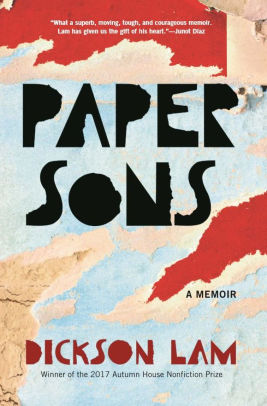A Review of Dickson Lam’s Paper Sons (Autumn House Press, 2018).
By Stephen Hong Sohn
Well, for anybody who is interested in Asian American studies, a title like Paper Sons is going to land squarely in their wheelhouse. At the same time, Dickson Lam’s creative nonfiction work (and debut) Paper Sons doesn’t necessarily draw from a personal account of having been a titular fictive genealogical child. Rather, Lam comes to understand his place as a Chinese American through a complicated trajectory. We get a crystalline view of his impoverished childhood and, later, through his concerted efforts to reform his life, we get a stronger sense of his cultural history. The official website provides this overview:
“Dickson Lam’s Paper Sons combines memoir and cultural history, the quest for an absent father and the struggle for social justice, naming traditions in graffiti and in Chinese culture. Violence marks the story at every turn—from Mao to Malcolm X, from the projects in San Francisco to the lynching of Asians during the California Gold Rush. After one of his former students at the June Jordan School of Equity is gunned down on a street corner, Lam is compelled to tell a mosaic of stories. What does it take, in this social context, to become a person who respects himself and holds hope for those coming up through a culture of exclusion and violence? Lam writes with a depth of hard-won understandings both political and psychological. This is an important book, beautifully crafted, rich in poetic image and juxtapositions, that offers insight and compassion for a nation struggling to make sense of its immigrant nature. I congratulate Dickson Lam on this fine work.”
This description provides a very useful condensation of the text, which is largely structured through vignettes and doesn’t have a standard chronology. The work opens up with a compelling and tragic account of Lam’s experiences as an instructor at June Jordan School of Equity. The death of Lam’s former student is the occasion not only to think about the complicated challenges of teaching, but also to ponder his own bumpy road toward becoming a teacher, one littered with misadventures, buses (and graffiti), and family dysfunction. Here, I should provide a spoiler alert because one of the most critical narrative throughlines is Lam’s rocky relationship with his father. Indeed, the fraying between father and son occurs very early on, especially as Lam’s father moves to Minnesota in search of better job opportunities, but which not surprisingly begins to create marital strain. It also becomes evident that Lam must reconcile his melancholic attachment to his father with the violence that Lam’s father perpetrated on his sister. So toward the work’s conclusion Lam admits, “For my part, I’m not done yet with Bah Ba. Probably never will be. In writing this book, I’d hoped to be freed from my father, that I’d exhausted my obsession with him, but our bond has only strengthened. He’ll remain a permanent character in my story. We’ve become pieces on a board game that will never end” (232). What is intriguing about this perspective is that he begins to position his own father as part of a genealogy of the chess games that have obsessed him in his adulthood. He begins to see his life as one that, though seeming unchangeable, could at least be entertained in other iterations through the imagination. And this alternative timeline is where he leaves us, with a sense of other possibilities, the kinds which, no doubt, inspire his teaching and drive him to advocate for students who come from backgrounds not so unlike his own. In this way, I found this particular memoir to possess an organic grittiness that was lacking from Michelle Kuo’s Reading with Patrick. In that particular work, it was evident that Kuo’s transitory teaching gig and similarly unstable teaching program would undo the inroads she had made as an instructor. In Paper Sons, we see an instructor who is trying to reorient the chess pieces, to create games with better outcomes, and to prepare a future path with more avenues not only for himself but for others. Kuo’s participation in the so-called system of educational games is unlike Lam’s: Lam situates himself as part of the game itself, thus drawing upon a very personal motivation that strikes the fire and stokes it to burn throughout this memoir. The other intriguing element of Lam’s Paper Sons is the importance of black culture and history on Asian American identity. Here, Lam clarifies that this connection is not so much appropriative, as it is informed by an alignment of a class-based community that moves across racial lines. This interracial perspective is one again that I thought separated itself from Kuo’s, which seemed more distant. Ultimately, a compelling work!
Buy the Book Here!
Review Author: Stephen Hong Sohn
If you have any questions or want us to consider your book for review, please don't hesitate to contact us via email!
Prof. Stephen Hong Sohn at ssohnucr@gmail.com
Xiomara Forbez, PhD Candidate in Critical Dance Studies, at xforb001@ucr.edu